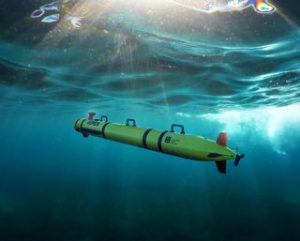The Navy recently announced it plans to procure the Lionfish Small Unmanned Undersea Vehicle (SUUV) from Huntington Ingalls Industries [HII].
On March 18, Naval Sea Systems Command issued a presolicitation notice that it will seek to buy the Lionfish from HII. While the Navy did not say how many units it plans to buy, the notice said it “has a requirement for the procurement of multiple production lots of the Lionfish Small Unmanned Undersea Vehicle, support equipment, production hardware spares, and Engineering Support Services.”
The Lionfish is set to replace the Mk 18 Mod 1 Swordfish UUV that is used for mine countermeasures and ocean survey. The Swordfish is based on the HII Remus 100 vehicles.
Last August, Capt. Dan Malatesta, the program manager for expeditionary missions in the Program Executive Office for Unmanned and Small Combatants, said the Mk 18 Mod 1 has essentially “maxed out its capability for computing power and those sorts of things,” Defense News reported
HII and L3Harris Technologies [LHX] were both under consideration for Lionfish and participated in operational evaluations hosted by the Defense Innovation Unit (DIU). The notice did not say if the Navy may award related contracts to L3Harris but that the requirement will be procured without the use of competitive procedures pursuant to title 10 of the U.S. Code.
As a replacement for the Swordfish, the Lionfish will primarily conduct intelligence gathering for expeditionary marine countermeasures missions. HII’s Lionfish offering uses its existing Remus 300 UUV.
According to an August presentation by Malatesta at the 2021 Sea Air Space expo, the Navy plans to procure up to 24 Lionfish SUUVs with delivery starting between 2022 and 2024.

The notice said HII’s unmanned systems unit “successfully completed” the Lionfish prototype effort previously awarded under a DIU Other Transactional Authority (OTA) contract using a competitive commercial solutions opening.
Last year, HII announced the release of the Remus 300 UUV as a man-portable system and described it as having options ranging from 100-150 pounds, 7.5 to 8.12 inches in diameter, 75 to 99 inches in length, and a maximum range of 29 to 89 nautical miles. The company said it can go up to 305 meters deep, reach speeds of five knots and has endurance options of up to 30 hours (Defense Daily, April 20, 2021).
Before HII finished acquiring Hydroid, the company delivered the first Remus 300 prototype to the DIU so the Naval Information Warfare Center could accept and characterize the vessel. At the time, then-owner Kongsberg said the Remus 300 UUV would be assessed as a possible solution for the Navy’s Next Generation Small-Class UUV program (Defense Daily, Feb. 14, 2020).
When announced last year, HII said initial orders for the standard configurations of the Remus 300 were expected to be delivered in the first half of 2022.
The Navy’s FY 2022 budget justification documents said the Lionfish class is to be a light-weight, highly portable and mission configurable vehicle for use by the Navy Explosive Ordnance Disposal, Naval Special Warfare, Naval Oceanographic Community, and Marine Corps operators.
“The program will deliver a baseline UUV capability and implement an incremental development approach, including phases for prototyping, integration, demonstration and fielding of Small Diameter UUVs to integrate with mission packages from each community,” the documents said.
Budget documents said in FY ‘22 testing and integration of forward-looking sonar and synthetic aperture sonar would begin and autonomy and automatic target recognition development will increase leading to compliance with the Unmanned Maritime Autonomy Architecture (UMAA).
FY ‘22 efforts are also set to cover “critical test and evaluation to demonstrate operational effectiveness and suitability against CNO-approved Top Level Requirements (TLRs).”
The budget documents indicated the Navy planned to downselect to the single contractor in the last quarter of FY ‘21, issue a DIU OTA option award in the first quarter of FY ‘22 and ultimately reach production OTA negotiation by the fourth quarter of FY ‘22.